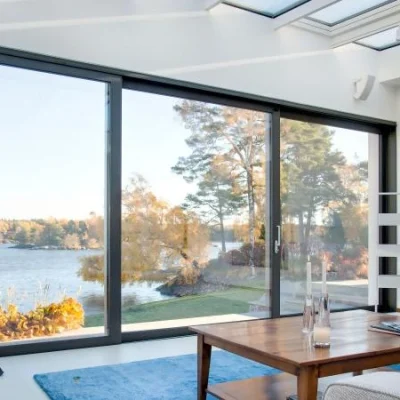What is the thickness of the aluminum door frame?
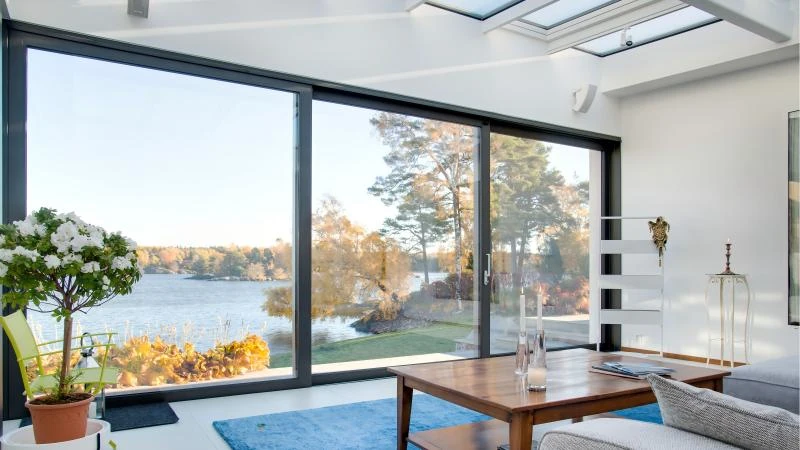
1. Aluminum Door Frames: Not Just "Frames", But the Core of Performance
(1) What Is an Aluminum Door Frame?
An aluminum door frame serves as the core structural component for securing door leaves. It not only bears the weight of the door and ensures stable operation but also elevates a space’s aesthetic appeal through thoughtful design. Boasting strong adaptability and a modern look, it is widely used in residences, shopping malls, office buildings, and other settings.
Compared to traditional materials like wood, PVC, and steel, aluminum door frames stand out with distinct advantages. They resist rust and corrosion, eliminating the need for frequent maintenance. Additionally, they can be crafted into slim profiles—paired with large glass panels, they create a sleek, transparent effect, balancing functionality and visual appeal for applications ranging from balcony sliding doors to office glass doors.
(2) Why Is Thickness a "Key Indicator"?
The thickness of a door frame directly defines its performance limits. Overlooking thickness during selection often leads to issues later on, with impacts seen in four key areas:
- Durability:Thicker frames offer stronger deformation resistance. Even with frequent use or minor impacts over time, they rarely bend or loosen, making them ideal for high-traffic areas.
- Energy Efficiency:Thicker frames provide ample space for thermal breaks, which reduce heat transfer between indoor and outdoor environments. This translates to less air conditioning use in summer and less heating in winter, cutting long-term energy costs significantly.
- Sound Insulation:Thicker frames excel at blocking external noise. For homes near busy streets or elevators, they drastically improve indoor quietness.
- Load-Bearing Capacity:When installing heavy door leaves (e.g., glass or metal doors) or large glass panels, thicker frames deliver robust support, preventing sagging or jamming.
2. Standard Thickness of Aluminum Door Frames: Match Specs to Scenarios
(1) Common Thickness Range: 30mm–60mm, Tailored to Needs
There is no "one-size-fits-all" thickness for aluminum door frames; specifications vary by door type and purpose. Common options include:
- 30mm–40mm:Focused on "slim simplicity", these suit aluminum bifold doors and indoor swing doors. Designed for lightweight use, slim frames maximize glass area, aligning with the minimalist style of modern homes.
- 40mm–50mm:Balancing "functionality and performance", this range is ideal for aluminum sliding doors and entry doors. It supports smooth sliding mechanisms while meeting basic thermal and sound insulation needs, making it perfect for residential balconies and entryways.
- 50mm–60mm:Engineered for "heavy load-bearing and high protection", these are primarily used for aluminum garage doors and fire-rated doors. Garage doors are heavy, and fire-rated doors must withstand high temperatures—thicker frames ensure long-term safety and compliance with safety standards.
(2) Three Core Factors Influencing Thickness Selection
Thickness should never be chosen arbitrarily; it must align with actual needs. Key considerations include:
- Door Type:Opt for slim frames for bifold and indoor doors, thick frames for garage and fire-rated doors, and medium-thickness frames for sliding and entry doors. This matching is based on door weight and usage conditions.
- Installation Environment:For "harsh environments" (e.g., open balconies, exterior walls facing busy streets), thicker frames are recommended for better resistance to wind, rain, and corrosion. For "mild environments" (e.g., indoor corridors, bedrooms), slim frames suffice.
- Functional Needs:Prioritize thick frames for quiet living or energy savings (pair with thermal breaks), and slim frames for a minimalist aesthetic. Functional priorities guide thickness choices.
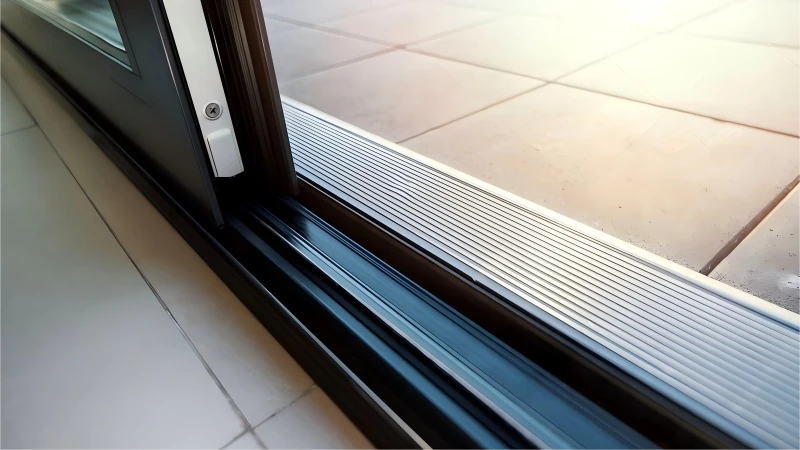
3. Must-Check Points Before Choosing Thickness: 5 Key Dimensions
(1) Scenario: Indoor vs. Outdoor Differences—Don’t Confuse Them
Indoor Scenarios:Bedroom and study doors face no exposure to wind or rain. Slim frames (30mm–40mm) work well and keep spaces feeling light.
Outdoor Scenarios:Entry doors, balcony doors, and garage doors endure sun, rain, and wind. A minimum thickness of 40mm is required, with 50mm–60mm frames offering superior durability.
Special Scenarios:Fire-rated or explosion-proof doors (subject to safety standards) must use 50mm–60mm thick frames, complying with local fire and building codes—no exceptions.
(2) Aesthetics: Slim Frames for Simplicity, Thick Frames for Stability
Modern Minimalist Style:30mm–40mm slim frames, paired with large glass, create a "frameless" look that enhances space transparency.
Traditional/Industrial Style:50mm–60mm thick frames add texture with bold lines, complementing retro or rugged designs.
(3) Energy Efficiency: Thick Frames + Thermal Breaks = The "Energy-Saving Combo"
Ordinary slim aluminum frames conduct heat quickly, leading to heat loss in winter and heat gain in summer. For energy efficiency, choose frames 40mm or thicker with built-in thermal breaks—this design blocks heat transfer, stabilizes indoor temperatures, and reduces long-term energy use.
(4) Sound Insulation: Thick Frames Reduce Noise—Choose Wisely for Quiet
For homes near busy streets, markets, or elevators, 50mm–60mm thick frames are optimal. Their wider profiles accommodate more sound-insulating materials; when paired with weatherstripping, they effectively block external noise for a quieter interior.
(5) Budget: Slim Frames for Short-Term Savings, Thick Frames for Long-Term Value
Limited Short-Term Budget:30mm–40mm slim frames have lower upfront costs, ideal for rental properties or temporary renovations.
Long-Term Occupancy:40mm+ thick frames are worth the slightly higher initial cost—they are more durable, require less maintenance, and avoid frequent replacements, saving money over time.
4. Aluminum Door Frame Sizes: Beyond Thickness, These Matter Too
(1) Standard Sizes: Single-Leaf vs. Double-Leaf Differences
Single-Leaf Frames:Typically 2032mm (80 inches) tall, 610mm–914mm (24–36 inches) wide, and 30mm–50mm thick—suitable for most residential entry and bedroom doors.
Double-Leaf Frames:Also 2032mm tall, 1219mm–1829mm (48–72 inches) wide, and 50mm–60mm thick—designed for wide openings like living room balconies or mall entrances.
(2) Customization: No Compromises for Special Door Openings
Non-standard openings (e.g., extra-high/wide) or unique designs (e.g., curved/irregular frames) call for custom aluminum frames. Notes for customization:
- Extra-high openings require thicker profiles (50mm+ for structural stability).
- For irregular frames, confirm craftsmanship with manufacturers in advance to ensure compatibility with door leaves.

5. Recommended Thickness for Different Scenarios
(1) Residential Scenarios: Choose by "Door Location"
- Bedroom/Study Doors:30mm–40mm slim frames (lightweight, space-saving).
- Balcony Sliding Doors:40mm–50mm medium frames (balances aesthetics and wind resistance).
- Entry Doors:40mm–50mm thick frames (paired with anti-theft locks for safety and insulation).
- Garage Doors:50mm–60mm thick frames (supports door weight, durable).
(2) Commercial Scenarios: Choose by "Foot Traffic"
- Office Indoor Doors:30mm–40mm slim frames (fits office simplicity).
- Mall Entrance Doors:50mm–60mm thick frames (endures frequent use, damage-resistant).
- Restaurant/Hotel Doors:40mm–50mm medium frames (balances sound insulation and aesthetics for better guest experience).
(3) Special Scenarios: Choose by "Safety Standards"
- Fire-Rated Doors:50mm–60mm thick frames (meets fire codes, maintains stability at high temperatures).
- Hospital/Laboratory Doors:40mm–50mm thick frames (paired with seals for dust and sound insulation).
6. How to Measure Thickness Yourself: A Step-by-Step Guide
(1) Essential Tools: Just 3 Items
- Tape Measure:For overall height/width of the frame (checks size compatibility).
- Calipers:For precise profile thickness (to the millimeter, avoids visual errors).
- Thickness Gauge:For measuring grooves or coated areas (ensures accurate local thickness data).
(2) Measurement Steps: "Installed" vs. "Uninstalled"
For Installed Frames:
- Use a tape measure to record depth (from inside to outside of the frame).
- With calipers, measure thickness at 2–3 points on the top and sides; take the average.
- Check corner thickness to ensure uniformity (prevents uneven stress during use).
For Uninstalled Frames (Profiles):
- First, confirm height/width matches the door opening.
- Use calipers to check thickness at multiple points (ensures no defects).
- For door leaf grooves, use a thickness gauge to measure depth (ensures smooth installation).
(3) Mistake-Proof Tips: 3 Key Reminders
- Measure Multiple Points:Avoid local thickness variations by checking several spots.
- Include Coating Thickness:Account for paint or laminates on the frame surface.
- Keep Frames Upright:Inclined frames cause inaccurate readings—ensure proper alignment first.
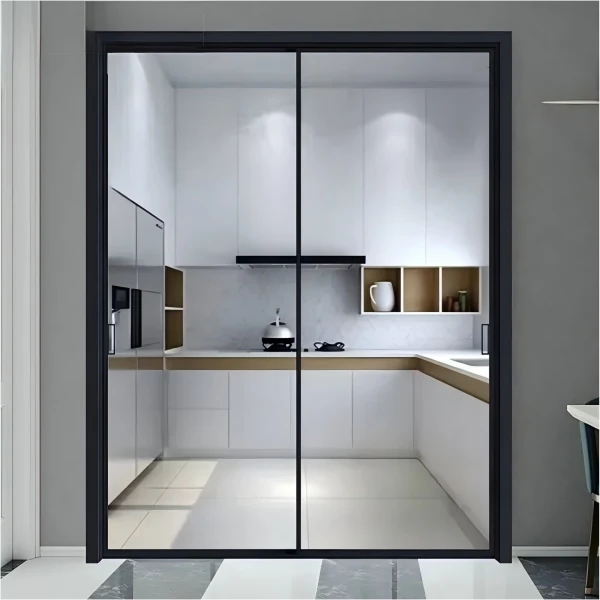
7. Slim Frames vs. Thick Frames: How to Decide?
| Comparison Factor | Slim Frames (30mm–40mm) | Thick Frames (50mm–60mm) |
|---|---|---|
| Aesthetics | Slim, lightweight, transparent | Sturdy, textured |
| Performance | Suitable for low-load use; average insulation | Ideal for high-load use; excellent insulation |
| Cost | Low upfront cost | Higher upfront cost; lower long-term maintenance |
| Best For | Indoor doors, bifold doors | Entry doors, garage doors, fire-rated doors |
In short:Choose slim frames for aesthetics, budget constraints, or indoor use; opt for thick frames for performance, long-term occupancy, or outdoor/special scenarios.
8. FAQs: Answers to Common Questions
- Q: Are thicker aluminum door frames always better?
A: No. While thick frames offer better performance, they are more expensive and space-consuming. Slim frames work perfectly for indoor doors—there’s no need to overbuy thickness.
- Q: What thickness is best for sliding doors?
A: 40mm–50mm is optimal. It supports sliding mechanisms without being bulky, balancing function and looks.
- Q: Aluminum frames are thinner than wood/PVC—are they less durable?
A: No. Aluminum resists corrosion and deformation; even with a thinner profile, it outperforms wood and PVC in durability and requires simpler maintenance.
- Q: Are there mandatory thickness standards for fire-rated door frames?
A: Yes. In China, fire-rated door frames typically require 50mm–60mm thickness, complying with GB 12955 General Technical Conditions for Fire-Rated Doors. Always check for certification when purchasing.
- Q: Can I choose any thickness for custom frames?
A: Not recommended. Thickness should be determined with manufacturers, considering opening size, door weight, and usage—improper thickness causes installation or functional issues.
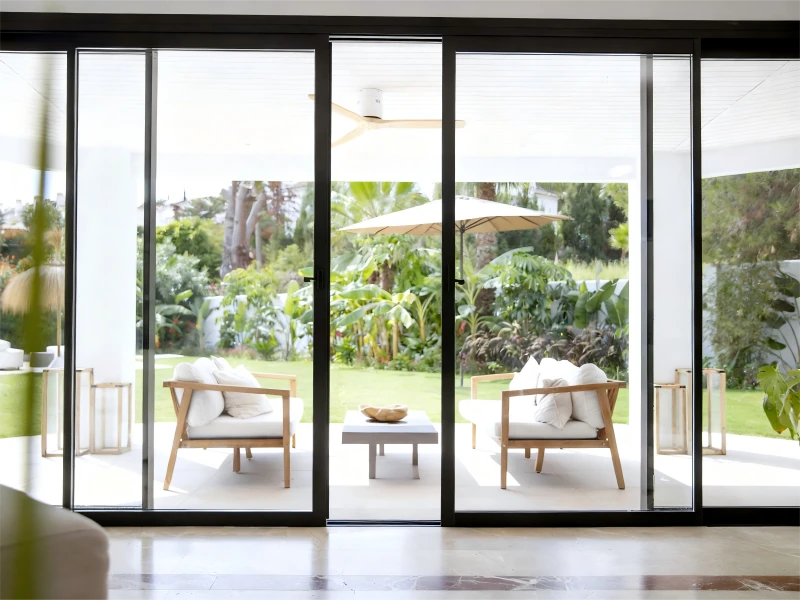
9. Summary: 3 Steps to Choose the Right Thickness
- Define the Scenario:Clarify indoor/outdoor use and special needs (e.g., fire protection, sound insulation).
- Match Specifications:Reference the 30mm–60mm range to narrow down suitable thickness.
- Balance Budget:Weigh upfront costs against long-term value—choose durability for self-occupancy, economy for rentals.
Choosing the right aluminum door frame thickness extends door life and boosts space comfort. Don’t overlook this small detail—it makes a big difference!
10. Call to Action
Unsure about the right thickness for your door frame? Share your opening size and usage scenario,Refer to our range of aluminum doors styles, and we’ll recommend a tailored specification. Have questions about installation or maintenance? Leave a comment to connect and avoid common pitfalls together!
Grab your tape measure and check your door opening size today—choose the perfect frame thickness to make your door a standout feature in your home!
